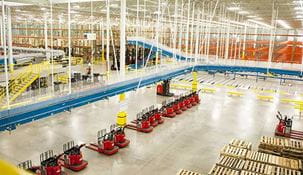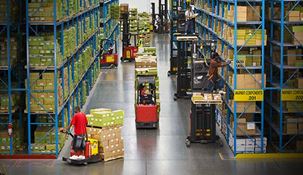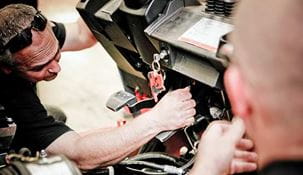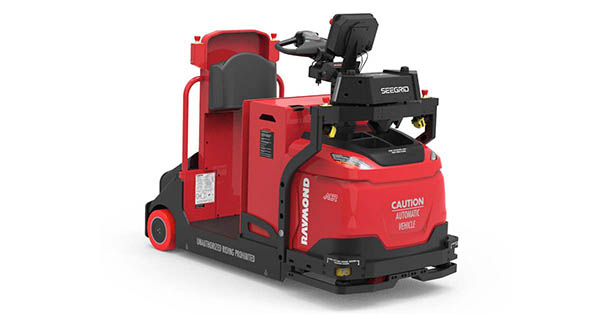Alabama Autonomous Guided Vehicle Supplier
What is an AGV?
Frequently described as autonomous guided vehicles or self-guided vehicles, automated guided vehicles (AGVs) are material handling systems or load carriers that travel autonomously across the floors of a warehouse, factory or DC without an onboard driver.
What are Automated Guided Vehicles used for?
Standard AGV applications include retrieval and storage in warehouses and DCs, generally in support of order picking. They are similarly employed for transportation of basic materials, work-in-process and finished goods in factories.
What are a few of the main advantages of Self-Guided Vehicles?
- Lowered Labor Costs: AGVs can substantially minimize labor expenses. A one-time cost can get rid of the continuous costs of salaries, taxes and benefits associated with a full-time worker.
- Increased Safety: Contemporary AGVs use advanced cameras, lasers or other sensors that allow them to "see" and react to their surroundings very quickly. Humans can become careless or distracted, whereas machines do not. AGVs can likewise be used in harsh environments or around dangerous materials where human safety is at risk.
- Increased Productivity & Accuracy: AGVs can work 24/7, never requiring breaks or getting fatigued. They can make distant treks across a warehouse quickly. They also don't make the types of mistakes that people are prone to making.
- Modularity: Most AGV solutions can be introduced gradually, displacing a few employees incrementally without a huge expenditure up front. As automation needs increase, more AGVs can easily be introduced to the operation.
How do AGVs work?
AGVs are directed by a mix of sensor-based guidance systems and software. They can navigate securely through a storage or manufacturing facility by utilizing obstacle detection bumpers and following thoroughly defined paths while using precisely regulated acceleration and deceleration.
AGV navigation is usually managed by one of these kinds of systems:
- Vision guidance: Cameras log the AGV's surroundings, and the vehicles use these cataloged videos to plot a course. Vision guidance is standalone, and as a result, no adjustment is needed to a warehouse or factory infrastructure for this type of navigation.
- Laser target navigation: With laser solutions, reflective tape is mounted to racks, walls, posts and other fixed objects. AGVs utilize laser transmitters to rebound laser beams off of these reflectors and then use the range and angle of objects to find a path.
- LiDAR: LiDAR systems send laser bursts to measure the range around the AGV and articles in its environment. This information is utilized to establish a 360-degree map of the setting. Like vision guidance, no adjustment of a facility is required.
- Inertial navigation: Transponders embedded into a building's floor surface route AGVs along a defined course.
- Wired navigation: These systems employ wire paths embedded into a warehouse or factory floor. The wire sends a signal that an AGV detects through a sensor or antenna system.
- Magnetic guide tape: This type of AGV uses magnetic sensors and conforms to a path laid out by magnetic tape.
What are the different types of Autonomous Guided Vehicles?
There are a number of kinds of automated guided vehicles. Lots of AGVs are similar to other human-operated vehicles yet are developed to function with no continuous human supervision or guidance.
- Forklift AGVs: Forklift automatic guided vehicles are an often-used type of AGV in warehouses. They're designed to transport pallets without the need for a human operator.
- Automated Guided Carts: An automatic guided cart is the most rudimentary kind of AGV. They can move all kinds of materials from pallets to small items. AGCs are regularly utilized in storage, sorting and cross-docking applications.
- Tugger AGVs: Towing or "tugger" AGVs pull non-powered, load-carrying carts trailing them in a train-like arrangement. These types of automated guided vehicles are typically utilized for transporting heavy loads over long distances. Many times, they are programmed to make several drop-offs and pickups along their course.
- Unit Load Handlers: Unit load handlers carry singular loads like particular objects or a discrete pallet or tote.
- Heavy Burden Carriers: These are used for extremely heavy loads like plates, castings or coils.
Automated Guided Vehicle Supplier Near Me
If you'd like a full analysis of AGV possibilities for your warehouse, DC or production center, you can talk to an expert at Carolina Handling.
-
-
Proudly serving
Mobile, Saraland,
Daphne, Fairhope, Foley,
Gulf Shores, Pensacola (FL),
Jackson, Monroeville, Evergreen,
Andalusia, Dothan, Blakely,
and the entire State of Alabama.
You May Also Like:

Automation
Carolina Handling can help you automate every aspect of your warehouse operation to increase efficiency.
Learn More

Optimization
Optimize everything in your warehouse to improve productivity and reduce operating costs.
Learn More

Warehouse Products
Looking for the right product for your operation? We have everything you need to do business in stock.
Learn More

Service Maintenance
Providing superior lift truck service and maintenance for our customers is Carolina Handling's highest priority.
Learn More



